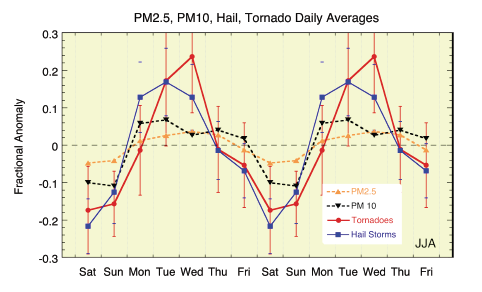Natural disasters such as hurricanes, wildfires, and volcanic eruptions can have a significant impact on air pollution levels worldwide. The damage caused by these events can result in the release of harmful pollutants into the atmosphere, leading to serious health and environmental consequences. Given the rise in extreme weather events, it has become pertinent to explore the two-way relationship between natural disasters and atmospheric air quality.
We first examine the case of tornadoes and hurricanes. Tornadoes are a violent and narrow rotating column of air that extends from a thunderstorm to the ground. They can move at extremely fast speeds up to 60 mph, bringing about mass destruction and fatalities in their wake.
Aerosol pollution decreases the size of water droplets coalescing in clouds, which prevents precipitation from occurring. Instead, they rise to much higher altitudes where they freeze and release additional heat. This process invigorates the storm by increasing lightning activity. The presence of particulate matter correlates with higher ambient temperatures, thus weakening cold pool formation which in turn facilitates the formation of tornadoes.
According to a team of researchers that study the weekly cycles of tornadoes, the number of tornadoes was 20% higher than average in the mid-week. This is thought to be linked to the industrial air pollution associated with the five-day workweek.

Fig 1: Fractional anomaly of particulate matter coincides with hailstorm and tornado events (Source: NASA, 2012)
Wildfires are another natural phenomenon associated with air pollution. It refers to fire within an area of combustible vegetation in the wilderness that includes forest and grassland. A warmer and drier climate due to global warming is expected to lead to more frequent and more intense fires near or within populated areas.
Besides smoke, wildfires release harmful fine particulates and pollutants including carbon monoxide, ash participles, methyl chloride, methyl bromide, polynuclear aromatic hydrocarbons, aldehydes, VOCs. A team of researchers analysed the impact of the 2002 Canadian forest fires on particulate matter air quality in Baltimore city, and found alarming evidence that the fires resulted in a 30-fold increase in ambient fine PM. Air quality levels exceeded the national standards even in areas thousands of kilometers away from the fires.
Fig 2 depicts the surge in 24-hour average PM2.5 concentrations in the event of a wildfire, as opposed to a typical day. Concentrations of particulate matter can be up to 20 times higher than usual, posing a significant threat to public health.

Fig 2: Air quality levels during wildfire season (Source: Henderson, 2020)
Volcanic eruptions are another significant source of air pollution during natural disasters. When a volcano erupts, it releases large amounts of ash, sulfur dioxide, and other gases into the atmosphere (Fig 3), worsening air quality. Sulfur dioxides can also cause acid rain to occur by reacting with oxygen and moisture in the atmosphere.

Fig 3: How volcanic eruptions impact the climate (Source: USGS)
For example, the eruption of Mount St. Helens in 1980 produced ash columns that rose as high as 80,000 feet in the sky and released 1.4 billion cubic yards worth of particles and volcanic matter. It caused the death of 57 people and countless wildlife while destroying 230 square miles of forested land.
Overall, natural disasters result in a large release of accumulated pollutants and fuel the development and intensity of future natural disasters, thereby perpetuating a vicious cycle.
Bibliography
BCCDC Foundation for Public Health. (n.d.). A Blanket of Smoke: Wildfire Smoke and Infant Health. Retrieved from https://bccdcfoundation.org/a-blanket-of-smoke-wildfire-smoke-and-infant-health/
Chandrappa, R., & Chandra Kulshrestha, U. (2015). Air Pollution and Disasters. Sustainable Air Pollution Management: Theory and Practice, 325–343. https://doi.org/10.1007/978-3-319-21596-9_8
Hänninen, O., Knol, A. B., Jantunen, M., Lim, T. A., Conrad, A., Rappolder, M. T., … & Carrer, P. (2016). Synergistic Effects of Ambient Temperature and Air Pollution on Health in Europe: Results from the PHASE Project. Int J Environ Res Public Health: 15(9): 1856. doi: 10.3390/ijerph15091856
Karstens, C. D., & Correia Jr, J. (2017). Hybrid prediction of weekly tornado activity out to week 3: utilizing weather regimes. Weather and forecasting, 32(5): 1785-1797.
Redd, N. (2012, January 5). Smoke from Australian Fires Reaches South America. What on Earth. NASA Blogs. Retrieved from https://blogs.nasa.gov/whatonearth/2012/01/05/post_1322634265523/
Sapkota, A., Symons, J. M., Kleissl, J., Wang, L., Parlange, M. B., Ondov, J., Breysse, P. N., Diette, G. B., Eggleston, P. A., & Buckley, T. J. (2005). Impact of the 2002 Canadian forest fires on particulate matter air quality in Baltimore city. Environmental science & technology, 39(1), 24–32. https://doi.org/10.1021/es035311z
Zimmer, C. (2020, May 18). Mt. St. Helens Eruption: What Happened 40 Years Ago. The New York Times. Retrieved from https://www.nytimes.com/2020/05/18/science/mt-st-helens-eruption.html

Leave a Reply